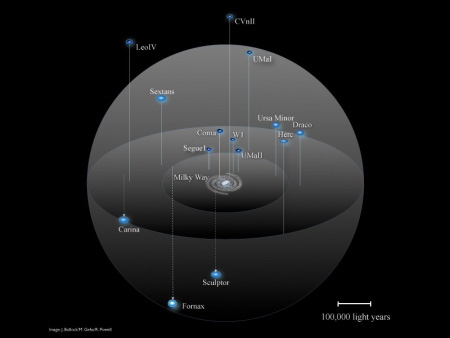Forged in FIRE: cusps, cores, and baryons in low-mass dwarf galaxies

Several studies have suggested that energy injection by time-variable stellar feedback can significantly affect the inner profiles of dark matter halos, especially in dwarf galaxies. In a recent paper (Onorbe et al.; arXiv:1502.02036), we show that the stellar feedback in the FIRE simulations can indeed produce kiloparsec-scale cores at the center of dwarf galaxy dark matter halos, potentially resolving discrepancies (including the “Too Big to Fail” problem) between observations of Milky Way satellites and dark matter-only simulations in the standard cold dark matter cosmology.
Abstract: We present ultra-high resolution cosmological hydrodynamic simulations of M_*~10^(4-6) Msun dwarf galaxies that form within M_v=10^(9.5-10) Msun dark matter halos. Our simulations rely on the FIRE implementation of star formation feedback and were run with high enough force and mass resolution to directly resolve stellar and dark matter structure on the ~200 pc scales of interest for classical and ultra-faint dwarfs in the Local Group. The resultant galaxies sit on the M_* vs. M_v relation required to match the Local Group stellar mass function. They have bursty star formation histories and also form with half-light radii and metallicities that broadly match those observed for local dwarfs at the same stellar mass. For the first time we demonstrate that it is possible to create a large (~1 kpc) dark matter core in a cosmological simulation of an M_*~10^6 Msun dwarf galaxy that resides within an M_v=10^10 Msun halo — precisely the scale of interest for resolving the Too Big to Fail problem. However, these large cores are not ubiquitous and appear to correlate closely with the star formation histories of the dwarfs: dark matter cores are largest in systems that form their stars late (z<~2), after the early epoch of cusp building mergers has ended. Our M_*~10^4 Msun dwarf retains a cuspy dark matter halo density profile that matches almost identically that of a dark-matter only run of the same system. Despite forming in a field environment, this very low mass dwarf has observable properties that match closely to those of ultra-faint satellite galaxies of the Milky Way, including a uniformly old stellar population (>10 Gyr). Though ancient, most of the stars in our ultra-faint form after reionization; the UV field acts mainly to suppress fresh gas accretion, not to boil away gas that is already present in the proto-dwarf.